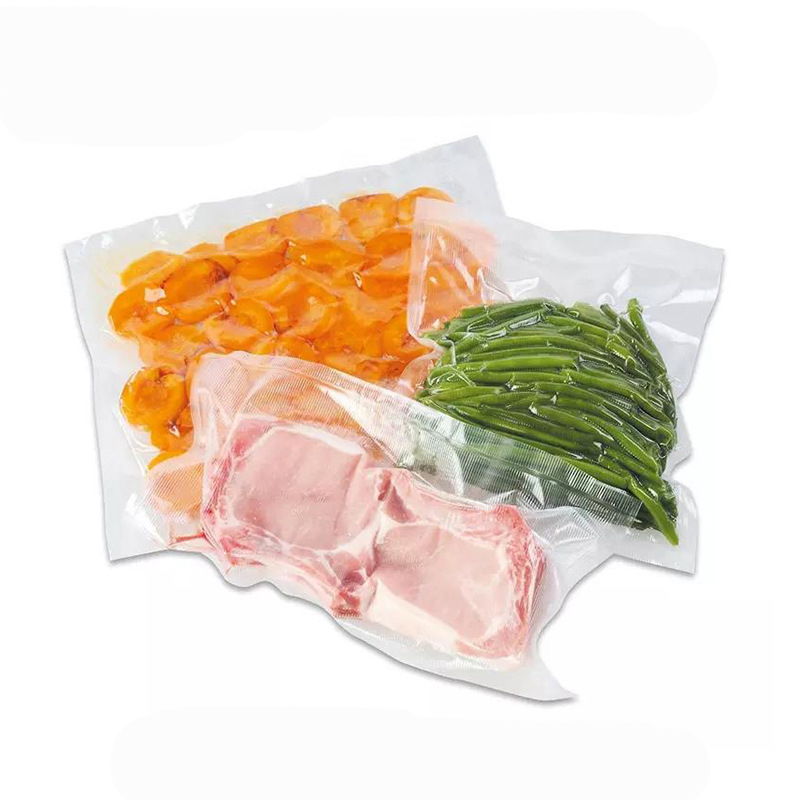Providing Best Services To Clients
Vacuum-sealed bags are a specialized packaging solution designed to remove air from the bag before sealing. This process preserves product freshness, extends shelf life, and protects the contents from external factors like moisture, oxygen, and contamination.
Air Removal Technology
Air is completely extracted, creating a tight seal that prevents spoilage and bacterial growth
Durable, High-Barrier Materials
Made from multi-layer laminates (e.g., Nylon/PE, PET/PE, PA/EVOH/PE) for enhanced strength and puncture resistance.
Leak-Proof Seals
Heat-sealed edges ensure no leaks, protecting both solid and liquid products
Flexible and Transparent Options
Available in clear, opaque, or printed designs, with optional matte or glossy finishes.
Customizable Sizes and Thickness
Available in clear, opaque, or printed designs, with optional matte or glossy finishes
Food-Grade Certified
Safe for direct food contact, ensuring compliance with international food safety standards.
Cost-Effective
Reduces food wastage and product loss by extending usability.
Versatile Usage
Suitable for solids, liquids, powders, and non-food items.
Can vacuum food bags be microwaved?
Vacuum bags made from microwave-safe materials can be used for reheating food. Always ensure the bag is slightly open to release steam and avoid pressure buildup
Are vacuum food bags safe for food storage?
Yes, vacuum food bags are made from BPA-free, food-grade materials and are safe for storing fresh, frozen, or cooked food. They comply with international food safety standards.
How do vacuum-sealed bags work?
Vacuum bags work by removing the air inside the bag using a vacuum sealer. The absence of oxygen slows down bacterial growth, prevents spoilage, and extends the shelf life of food items. Once the air is removed, the bag is sealed tightly to keep the contents fresh.

Providing Best Services To Clients
Vacuum-sealed bags are a specialized packaging solution designed to remove air from the bag before sealing. This process preserves product freshness, extends shelf life, and protects the contents from external factors like moisture, oxygen, and contamination.
Air Removal Technology
Air is completely extracted, creating a tight seal that prevents spoilage and bacterial growth
Durable, High-Barrier Materials
Made from multi-layer laminates (e.g., Nylon/PE, PET/PE, PA/EVOH/PE) for enhanced strength and puncture resistance.
Leak-Proof Seals
Heat-sealed edges ensure no leaks, protecting both solid and liquid products
Flexible and Transparent Options
Available in clear, opaque, or printed designs, with optional matte or glossy finishes.
Customizable Sizes and Thickness
Available in clear, opaque, or printed designs, with optional matte or glossy finishes
Food-Grade Certified
Safe for direct food contact, ensuring compliance with international food safety standards.
Cost-Effective
Reduces food wastage and product loss by extending usability.
Versatile Usage
Suitable for solids, liquids, powders, and non-food items.
Can vacuum food bags be microwaved?
Vacuum bags made from microwave-safe materials can be used for reheating food. Always ensure the bag is slightly open to release steam and avoid pressure buildup
Are vacuum food bags safe for food storage?
Yes, vacuum food bags are made from BPA-free, food-grade materials and are safe for storing fresh, frozen, or cooked food. They comply with international food safety standards.
How do vacuum-sealed bags work?
Vacuum bags work by removing the air inside the bag using a vacuum sealer. The absence of oxygen slows down bacterial growth, prevents spoilage, and extends the shelf life of food items. Once the air is removed, the bag is sealed tightly to keep the contents fresh.

Applications of Vacuum-Sealed Bags
Food Preservation
Meats, poultry, and seafood (raw or cooked)Vegetables, fruits, and frozen itemsCoffee beans, tea leaves, and dry foods (rice, flour, nuts, grains)Dairy products like cheese
Industrial and Medical Use
Electronic components (protection from moisture and oxidation)Pharmaceuticals and medical instrumentsSmall hardware items (bolts, screws, and tools)
Clothing and Textiles
Vacuum storage for apparel, bedding, and linens, reducing storage volume
